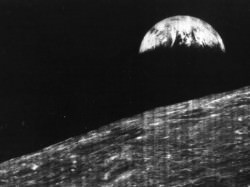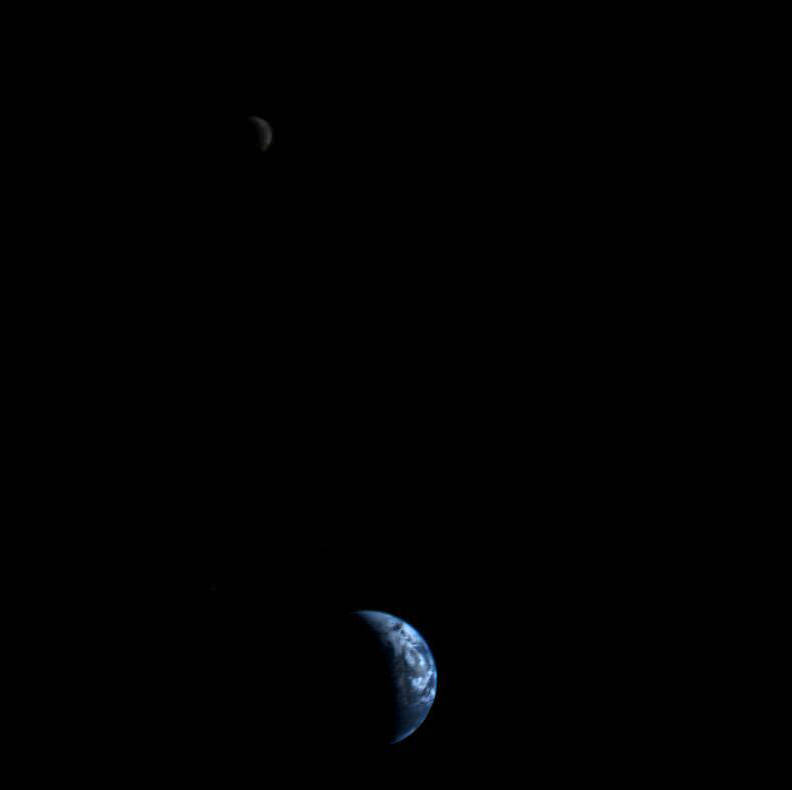A crescent Earth and Moon as seen by Voyager 1 on September 18, 1977 (NASA)
35 years ago today, September 18, 1977, NASA’s Voyager 1 spacecraft turned its camera homeward just about two weeks after its launch, capturing the image above from a distance of 7.25 million miles (11.66 million km). It was the first time an image of its kind had ever been taken, showing the entire Earth and Moon together in a single frame, crescent-lit partners in space.
The view of Earth shows eastern Asia, the western Pacific Ocean and part of the Arctic. Voyager 1 was actually positioned directly above Mt. Everest when the images were taken (the final color image was made from three separate images taken through color filters.)
The Moon was brightened in the original NASA images by a factor of three, simply because Earth is so much brighter that it would have been overexposed in the images were they set to expose for the Moon. (Also I extended the sides of the image a bit above to fit better within a square format.)
Read the latest on Voyager 1: Winds of Change at the Edge of the Solar System
 Previous images may have shown the Earth and Moon together, but they were taken from orbit around one or the other and as a result didn’t have both worlds fully — and in color! — within a single frame like this one does. In fact, it was only 11 years earlier that the very first image of Earth from the Moon was taken, acquired by NASA’s Lunar Orbiter I spacecraft on August 23, 1966.
Previous images may have shown the Earth and Moon together, but they were taken from orbit around one or the other and as a result didn’t have both worlds fully — and in color! — within a single frame like this one does. In fact, it was only 11 years earlier that the very first image of Earth from the Moon was taken, acquired by NASA’s Lunar Orbiter I spacecraft on August 23, 1966.
It’s amazing to think what was happening in the world when Voyager took that image:
• World population was 4.23 billion (currently estimated to be 7.04 billion)
• The Space Shuttle Enterprise made its first test flight from a 747
• Star Wars, Close Encounters of the Third Kind and Saturday Night Fever were out in U.S. theaters
• Charlie Chaplin and Elvis Presley died
• U.S. federal debt was “only” $706 billion (now over $16 trillion!)
• And, of course, both Voyagers launched on their Grand Tour of the Solar System, ultimately becoming the most distant manmade objects in existence
(See more world stats and events here.)
Image: NASA/JPL
“Once a photograph of the Earth, taken from outside, is available – once the sheer isolation of the Earth becomes known – a new idea as powerful as any in history will be let loose.”
– Sir Fred Hoyle


Wow. I had no idea the Moon was so dark in colour. It doesn’t look nearly as black from down here.
A truly awesome portrait of the Earth-Moon system:
In greater view of planetary-ruin of Solar-frame—from a shrunken, radiation-burned world of lead-melting heat, to the cold-distance of a gas-extended, Triton-holding Ice Giant—one terrestrial World revolves in living-color and vibrant motion, gently orbiting the Sun’s-sphere of habitability, faithfully-embraced by a lunar companion of world-sustaining stability.
An ocean-water-planet, marvelously arrayed with curiously configured Landmasses, and life-sustaining air-vault, superbly-enveloped. Within a field of Electromagnetism, well shielded. Finely balanced and governed in time by seasonal cycles, through revolutions of years: the motions of concentric time—clocked by a powering, world-centering star, and an Earth-held Moon of orbital turn—the graceful tidal dance to gravity’s recurring rhythms, in elegant patterns through Space.
Once this World of Man has been framed in one illuminating perspective of distance (from epic voyage past)—capturing one unique, incredible life-oasis in time—animated with life—isolated as it is in the broad-view of the Solar System’s expanse of uninhabited wastelands, magnificent in desolation, “a new idea as powerful as any in history will be let loose”. Yet, in some profound way, that “new idea” loosed, could be related to an old concept; one as ancient as man’s long journey through time. ….
“Quietly, like a night bird, floating, soaring, wingless
We glide from shore to shore, curving and falling
but not quite touching;
Earth: a distant memory seen in an instant of repose,
crescent shaped, ethereal, beautiful,
I wonder which part is home, but I know it doesn’t matter . . .
The bond is there in my mind and memory;
Earth: a small, bubbly balloon hanging delicately
in the nothingness of space.”
Alfred M. Worden,
Apollo 15 Astronaut.
See me? Over on the opposite side of the earth? Three years old?